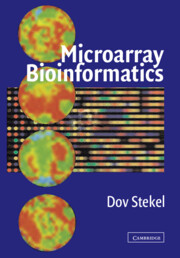Book contents
- Frontmatter
- Contents
- Foreword
- Preface
- Acknowledgments
- MICROARRAY BIOINFORMATICS
- 1 Microarrays: Making Them and Using Them
- 2 Sequence Databases for Microarrays
- 3 Computer Design of Oligonucleotide Probes
- 4 Image Processing
- 5 Normalisation
- 6 Measuring and Quantifying Microarray Variability
- 7 Analysis of Differentially Expressed Genes
- 8 Analysis of Relationships Between Genes, Tissues or Treatments
- 9 Classification of Tissues and Samples
- 10 Experimental Design
- 11 Data Standards, Storage and Sharing
- Appendix: MIAME Glossary
- Index
- Plate section
3 - Computer Design of Oligonucleotide Probes
Published online by Cambridge University Press: 15 January 2010
- Frontmatter
- Contents
- Foreword
- Preface
- Acknowledgments
- MICROARRAY BIOINFORMATICS
- 1 Microarrays: Making Them and Using Them
- 2 Sequence Databases for Microarrays
- 3 Computer Design of Oligonucleotide Probes
- 4 Image Processing
- 5 Normalisation
- 6 Measuring and Quantifying Microarray Variability
- 7 Analysis of Differentially Expressed Genes
- 8 Analysis of Relationships Between Genes, Tissues or Treatments
- 9 Classification of Tissues and Samples
- 10 Experimental Design
- 11 Data Standards, Storage and Sharing
- Appendix: MIAME Glossary
- Index
- Plate section
Summary
INTRODUCTION
An oligonucleotide probe is a short piece of single-stranded DNA complementary to the target gene whose expression is measured on the microarray by that probe. In most microarray applications, oligonucleotide probes are between 20 and 60 bases long. The probes are either spotted onto the array or synthesised in situ, depending on the microarray platform (Chapter 1).
Usually, oligonucleotide probes for microarrays are designed within several hundred bases of the 3′ end of the target gene sequence. So for a fixed oligonucleotide length, there are several hundred potential oligonucleotides, one for each possible starting base. Some of these oligonucleotides work better than others as probes on a microarray. This chapter describes methods for the computer selection of good oligonucleotide probes.
What Makes a Good Oligonucleotide Probe?
Good oligonucleotide probes have three properties: they are sensitive, specific and isothermal.
Asensitive probe is one that returns a strong signal when the complementary target is present in the sample. There are two factors that determine the sensitivity of a probe:
▪ The probe does not have internal secondary structure or bind to other identical probes on the array.
▪ The probe is able to access its complementary sequence in the target, which could potentially be unavailable as a result of secondary structure in the target.
A specific probe is one that returns a weak signal when the complementary target is absent from the sample; i.e., it does not cross-hybridise. There are two factors that determine the specificity of a probe:
▪ Cross-hybridization to other targets as a result of Watson–Crick base-pairing
▪ Non-specific binding to the probe; e.g., as a result of G-quartets
- Type
- Chapter
- Information
- Microarray Bioinformatics , pp. 43 - 61Publisher: Cambridge University PressPrint publication year: 2003



